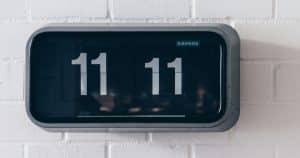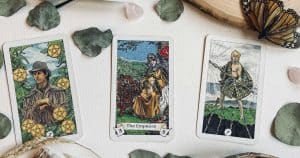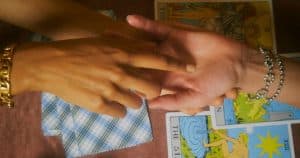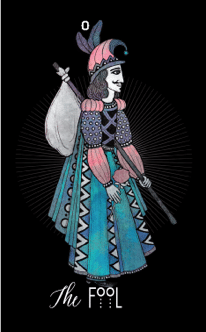Mastering Reversed Tarot Cards: A Comprehensive Guide to Interpretation and Meaning
Sometimes when you shuffle the tarot deck, you will get an upright card. Does an upside-down bring different meanings? An upside-down card can certainly change the intuitive message of a reading, but it doesn’t mean your are cursed or going to suffer bad luck.
There’s a stigma that suggests reversed tarot cards mean bad news. This isn’t the case. A reversed card can mean several different things depending on the card itself and its place in the spread.
It can be helpful to work with a professional tarot reader or consult a tarot book to interpret reversed tarot cards. Some readers even refuse to read with reversals. This can all come down to personal preference. Every tarot session is unique to the practicioner as well as the querent. If you are new to tarot and tarot reversals, this is your ultimate guide.
What is a Reversed Tarot Card?
A reversed tarot card is any one of the 78 tarot cards that come out upside down in a reading. An upright position tends to represent the archetype of the card in its purest form, while every tarot card can use reversed meanings, too.
How to Read a Reversed Tarot Card
Some readers read reversed tarot cards with their upright meaning to simplify readings. After all, you’re already working with 78 cards.
Tarot is about intuition, skill, and experience, so there’s no write or wrong answer. But, if you do choose to read reversed cards, here are five common ways to interpret them. When consulting tarot, it is also very important to look at the surrounding cards as well. With 78 tarot card meanings already distilled into specific categories, a card turned upside down brings further layers of insight to your session.
Decreased Intensity
Some see reversed cards as carrying a dialed back energy of the card’s upright meaning.
For example, the Nine of Swords carries the meanings of nightmares, stress, anxiety, and negative thoughts. In reverse, this card could suggest that you are moving away from a period of deep inner turmoil into calmer waters. If you pull The Tower in the reverse, this could indicate that you have just gone through some major upheavals and the period you are in now is the calm after the storm.
Increased Energy
Simply put, take the basic meaning of the card you pulled and amplify it. Since all the cards carry a balanced energy to them, a way to read them in reverse is to see an intensified energy. For example, if you pull the Four of Cups in a reversed position, this could signal that you are going through a period of immense grief and loneliness or pulling something like The Heirophant in reverse could suggest you are expanding your spiritual practices or receiving a huge karmic lesson.
Delays and Blockages
Another way you can read tarot card reversals is to interpret them as delays or blockages on the querent’s path. In some tarot spreads, you can read the cards as telling a narrative of past, present, future and a reversed tarot card could indicate a foreseeable blocked energy in the way. For instance, pulling The Fool upright and having it being crossed by the Seven of Swords could suggest that there is someone being dishonest around you that may be holding you back and preventing you from taking a leap of faith. It may be drawing your attention to the importance of looking before you leap as your current energy implies that not everyone around you has your best intentions at heart.
Internalized Energy or Opposite Meaning
Taking the upright meaning of the tarot card and interpreting it as the opposite energy or internalized energy is another common way of reading reversals. This can be useful for smaller spreads but overall, it tends to simplify the meaning of the card too much. An example of this would be pulling the Five of Wands, a card about outer conflict, arguments, tension, and ego, and seeing it as a card of internalized conflict, inner turmoil, conflict avoidance, and released tension. Another instance would be if you pulled the King of Cups (an emotionally mature character, someone who has mastered their emotions) and seeing it as struggling to control emotions, being emotionally manipulative, or being emotionally immature.
Yes/No Tarot
You can also use tarot card reversals as a way to answer yes/no questions. Upright tarot cards can show you the yeses in a reading or where the energy has been mastered and reversed tarot cards can indicate the no’s or where the energy has not been mastered. Tarot readers who use reversals tend to find that they can layer different cards in the spread to illuminate further depth. Sometimes yes and no tarot readings use one card and this can help you to hone your intuitive tarot readings. Oracle cards can also be used in this way, too.
How to Decide if Reading Reversed Tarot Cards is Right For You
If you’re just dipping your toe into the world of tarot, reading reversals can be extremely overwhelming. However, if you’re getting more familiar with the meanings of the cards and looking to uncover more layers in your readings, reading reversals can help immensely. Try out a few different ways of reading reversals to find the one that speaks most for you. This extra layer of insight from each specific card will speak to you and you will know intuitively.
At the end of the day, whether you read reversals or not, you will still be able to conduct excellent tarot readings as there is no right or wrong way to read the cards. Take what resonates, leave the rest.












